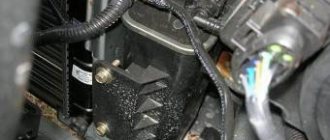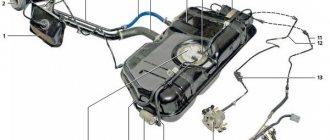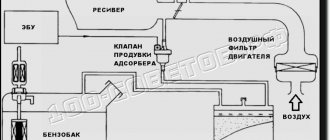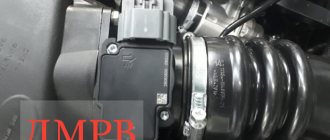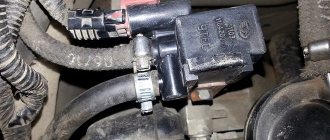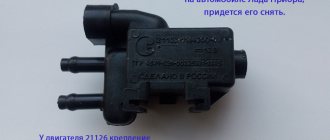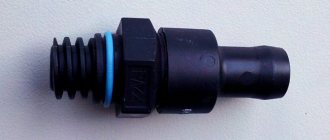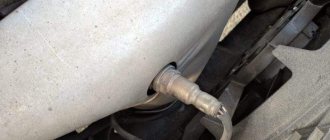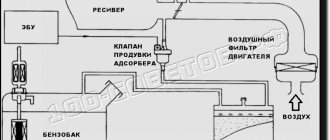Adsorber or absorber, which is correct? Any internal combustion engine is a source of emissions of harmful substances into the environment. New methods are being invented and old ones are being improved to reduce harmful emissions. Today, environmental friendliness is the reputation of a car manufacturer. For example, in order to comply with the environmental friendliness of Euro 3 engines, a capture device must be installed in the vehicle design, which will ensure lower CO2 emissions.
Fuel absorber
An absorber is a device that absorbs gases and vapors that appear at the outlet of the fuel tank as a result of heating and evaporation. From the Latin sorbeo translates as absorb.
When a car's internal combustion engine is running, the trapped vapors are sent to the fuel injection system - to the intake manifold.
When the engine is not running, part of the fuel vapor is captured by the separator and sent back to the gas tank, and part is captured by the fuel vapor adsorber, where they are neutralized.
Why do you need an absorber in a car?
The automobile fuel absorber appeared when the Euro2 engine environmental class was established. Environmental standards do not allow gasoline vapors to escape into the atmosphere, as this greatly pollutes the environment. Fuel vapors should not enter the car interior.
Such a filtration system does not exist in cars with carburetors. Absorbers began to be installed on cars with injection internal combustion engines.
Is it possible to remove the adsorber? Pros and cons of turning off the system.
The adsorbent system is an integral component of a modern vehicle. A properly functioning filter does not affect the functioning of the engine. Moreover, it allows you to save a little on gasoline, because the trapped fuel vapors are not thrown out, but burn in the engine.
Is it possible to ignore environmental standards and remove the adsorber from the car? This can be done, and it will not affect the operation of the car in any way. From a technical (but not environmental) point of view, this is even better - vapors from the tank will escape directly into the environment, and without additional cans, valves and tubes, the reliability of the car will increase.
It is not difficult to carry out this manipulation - you need to connect a fine filter to the separator through a hose, shut off the adsorber itself and do chip tuning (engine firmware).
Disabling the adsorber has other positive aspects:
- the engine compartment space is significantly freed up, because the system (especially the filter bank) takes up a lot of space;
- the known problem of unstable engine idle operation disappears;
- There is a small cost savings due to the unnecessary purchase of a new adsorber and valve in the event of their breakdown.
At the same time, we should not forget what threatens the shutdown of the adsorbing system, namely:
- There will be a smell of gasoline inside the car, because some of the vapor will go into the cabin;
- light hydrocarbons will be released into the atmosphere and pollute the environment;
- the car itself (outside) may also begin to smell of fuel.
About why an adsorber is needed, how it works, and how to check it, see the following video:
The adsorbent system is a fairly simple but useful component of a car. Maintenance of this element is not difficult or expensive, but if desired, you can go against environmental standards and turn off the adsorber, slightly increasing the reliability of the machine.
That's all for me today. If you have any questions, or if you want to add to the article, write comments.
Best regards, administrator
Automotive absorber design
In simple words, the absorber design is a plastic jar with a filled filter catching element. The best substance for trapping and neutralizing fuel vapors is activated carbon.
The absorber consists of:
- Separator. The separator captures gasoline vapors and sends them back to the fuel tank.
- Gravity valve. It protects against fuel overflow if the car overturns. The valve blocks the movement of fuel.
- Pressure meter. The pressure sensor performs an important function - it monitors the vapor pressure in the fuel tank. When the maximum permissible pressure in the tank is reached, the sensor opens and releases the pressure.
- Filter element (activated carbon). The filter element in a car absorber is carbon in large granules. Large granules allow vapor to pass through the layer of carbon powder and condense.
- Connecting tubes. Connecting tubes serve to connect all structural elements.
- Solenoid valve. The solenoid valve changes the fuel vapor recovery modes.
Reviews have been published about the performance of the Full Free fuel saver.
Malfunctions
The node is quite reliable; rare problems with it manifest themselves as:
- breakage of fittings due to natural aging of plastic;
- contamination of activated carbon from a long service life, up to complete obstruction;
- electrical and mechanical failures of the purge valve;
- short circuits and loss of contact in electrical wiring;
- loss of tightness of hoses due to rubber hardening.
All this leads to an increase or decrease in idle speed, uncertain starting, increased consumption and decreased traction. Usually the ECU notices deviations and displays an error on the instrument panel.
There is even a separate section of the standard error code table dedicated to gasoline vapor recovery equipment.
Principle of operation
One of the most important elements in the design of the absorber is the solenoid valve, on which the operation of the entire cleaning system depends.
VAZ 2110 diagram
Operating principle and vapor movement in the system:
Gasoline vapor rises to the top of the fuel tank and is captured by a separator, which works in conjunction with a gravity sensor. The gravity sensor ensures safety and prevents fuel from leaking out of the tank in the event of an accident. The captured vapors in the separator condense (take on a liquid form) and return to the fuel tank.
The rest of the fuel vapor enters the absorber, where it accumulates and is neutralized. Accumulation in the absorber occurs when the engine is not running!
After the vehicle’s internal combustion engine is started, the solenoid valve opens and provides a connection between the absorber cavities and the intake manifold or throttle assembly (depending on the design). The purging process begins! Air from the street enters through the throttle valve and mixes with fuel vapor. Next, this mixture is sent to the intake manifold, from where it is supplied to the cylinders. This is how fuel vapors from the absorber are burned.
What is the adsorber used for?
During operation of the vehicle engine, gasoline heats up slightly, releasing very volatile vapors. Their formation is enhanced by the vibration of a moving vehicle. If the vehicle does not have a system for neutralizing harmful fumes, and primitive ventilation is installed, then the formations are simply discharged to the street through special openings.
This picture was observed with almost all old carburetor cars (which is why the car often smelled unpleasantly of gasoline) before the advent of the EURO-2 environmental standard, which controlled the level of harmful fumes into the atmosphere. Today, every car must be equipped with an appropriate filtration system to meet the standards. As a rule, the simplest of them is the adsorber.
Absorber valve: what is it for and what does it affect?
The valves in the absorber are a technically simple device that operate differently depending on whether the engine is running or not. Like all valves, it must open and close.
When the absorber cavity is clogged or some other malfunction occurs, the valve malfunctions. With a faulty adsorber valve, serious vehicle damage can occur because pressure is not released from the fuel tank and the cavity is not purged.
Symptoms of Absorber Valve Problems
There are several signs and symptoms that can help identify the technical condition of the valve:
- The fuel gauge shows either a full tank or an empty one.
- After starting the engine, after 5-10 minutes the revolutions begin to fluctuate.
- At idle speed, when you press the pedal, the car begins to stall.
- The engine does not gain speed when driving. It takes a long time to accelerate.
- When opening the gas tank cap, a vacuum is felt and a whistle is heard.
- Increased fuel consumption.
- When it’s cold (when the engine is running but not yet warmed up), knocking noises from the absorber are heard, as if valves are knocking.
The cause of absorber failure is not always the valve. This may be severe contamination of the absorbent element, in this case coal. Gases should easily pass through the coal granules and condense there.
The valve is very cheap. Therefore, it is possible to change if signs of improper engine operation are detected. You can also replace the adsorber filter element with your own hands: disassemble it, pour out the old coal, pour in new coal in large granules.
How to replace the adsorber valve
First of all, if the absorber ventilation on the machine does not work, repair is necessary. Regardless of which car the breakdown occurred on (foreign car, Lada Priora or Kalina), the adsorber and its valve should work normally. Otherwise, all the problems discussed above will appear to a greater or lesser extent.
At the same time, we note that replacing the adsorber valve with your own hands in most cases is quite possible in an ordinary garage. This means that it is not always necessary to go to the service.
- First, if we consider the adsorber valve itself, the price of this device is usually not high;
- Second, having studied the design of a particular car, it is necessary to determine where the adsorber purge valve is located.
- As a rule, to replace the valve you need to have a pair of Phillips screwdrivers.
We also recommend reading the article about what signs indicate a faulty oxygen sensor, as well as how to understand that the lambda probe is faulty. From this article you will learn about the main symptoms of a malfunctioning oxygen sensor, as well as available methods for checking this element.
Replacement is quite simple. The main thing is to choose a valve for installation so that its markings are exactly the same as on the valve that was previously on the machine. After purchasing the required valve, it is enough to remove the terminals from the battery, disconnect the “chip” with wires from the valve, and unscrew the valve fastenings.
Then you will need to remove the fittings under the latch and also disconnect the hoses. Then you can remove the valve and its bracket from the adsorber. Now you can install the new valve and reassemble it. At this point the replacement can be considered complete.
The only thing is that on some cars you may still need to reset the error in the ECU memory. By the way, this can be done using a simple solution like ELM327 or other diagnostic equipment.
What happens if you remove the fuel vapor absorber valve
Is it possible to remove the valve completely? Some people do this, thinking that because of the valve, fuel consumption increases and the car accelerates more slowly.
In fact, if the adsorber and valve are working properly, then the internal combustion engine, on the contrary, works like a clock and the consumption is at the optimal level. The savings are not as noticeable from burning off the remaining fuel vapor, but there is also less choice for the atmosphere.
To the question, is it possible to remove the absorber valve completely? Answer: yes, you can. The engine is not affected by its presence or absence. It only affects if it is installed and faulty.
Disadvantages of a car without a valve and absorber:
- the smell of gasoline in the cabin;
- environmental pollution;
Advantages of a machine without valve and absorber:
- there is more space under the hood (this may be important to some);
- no need to change the absorber and valve.
Owners of carburetor cars, I think, remember how the car’s interior often smelled of gasoline, which is why some people get headaches. For this alone, it is better not to remove the valve and absorber, but to replace them in a timely manner in case of breakdowns.
Problems with the purge valve
The most common problem with the purge valve is when it sticks or doesn't close completely. This may cause the Check Engine to come on.
In some vehicles, a stuck purge valve can cause difficulty starting immediately after refueling: the engine may run rough and jerk for the first few seconds.
CPA problems are common in many cars. Some early 2000s Hyundai models (Elantra, Santa Fe, Tucson, Tiburon) often have a stuck purge valve, causing trouble code P0441.
Similar problems are quite common in many European cars, including Audi and Volkswagen. In some Mazda vehicles, a faulty valve can cause code P0446 and other EVAP codes.
The purge valve is not very expensive and is easy to replace.
Causes of malfunction of the adsorber on Priora and features of its self-check
The adsorber contains activated carbon in granular form, which gets wet over time, which reduces the level of air permeability. Typically, such a malfunction is accompanied by error on BC P0441. However, in addition, a more common problem is when coal particles enter the body of the solenoid valve and, accumulating in large quantities, do not allow it to close, which leads to the problem of floating speed on Priora.
The causes of adsorber malfunction are the following factors:
- Depressurization of the adsorber housing. Usually occurs in case of mechanical damage. If such a breakdown occurs, the part must be replaced.
- Damage to the integrity of the power supply wires of the solenoid valve. In this case, errors P0443/P0444/P0445 and P0446 are displayed. This could be an open circuit, short to ground, or low voltage.
- Air inlet fitting and filter element are dirty. Air enters the device through the inlet fitting, as a result of which accumulated vapors are purged. Through the fitting, contaminants enter the adsorber, which leads to a decrease in the level of air permeability. This causes the device to operate ineffectively.
To determine the cause of the malfunction, you will need to focus on the corresponding errors or symptoms. For example, if there is a suspicion of a violation of the seal of the housing, then it is necessary to remove the adsorber and inspect its condition. If no defects are found, then its tightness is usually checked as follows:
- the connections to the atmosphere and to the solenoid valve are plugged;
- compressed air is supplied to the remaining fitting connecting the device to the gas tank;
- the absence of signs of air leakage indicates the integrity of the adsorber housing.
Be sure to inspect the integrity of the power wires of the solenoid valve, and if necessary, call them. If there is a suspicion that the valve is jammed in the open position, then a simple and reliable way to check is to start the engine and plug the fitting connecting the adsorber to the atmosphere with your hand. If after this the engine operation changes, then the cause of the malfunction has been identified, and all that remains is to eliminate it by replacing the part.
It is important to note that if the adsorber is dirty, it must be replaced. This device is non-separable, and if a malfunction is suspected, it must be replaced. As for the resource, there are no exact figures here. The service life depends on many factors, including the quality of the device itself.
This is interesting! The adsorber on Priora has the following article number 2170-1164010. Its price is approximately 500-800 rubles.
Purpose of the node and its physical structure
The adsorber is used to remove gasoline vapors from the air escaping when the gas tank is ventilated.
Previously, these vapors were discharged outside, at best, through a valve, or even simply through a vent hole in the gas tank cap. With the tightening of environmental regulations, this has become unacceptable. And gasoline was consumed in this way, albeit slowly, but constantly, which led to unproductive losses. The idea of the adsorber is to separate hydrocarbons from air by passing it through a microporous structure, which is specially obtained coal in powder form. The pore volume is very large; they are capable of holding a significant amount of fuel. But not endless, so the device needs periodic cleaning. To do this, it is purged, and the extracted gasoline enters the engine, where it burns, producing useful work.
Changing the device yourself
To change the adsorber, it is enough to perform a number of simple manipulations. In this case, there are two solutions - do the work yourself or go to a service station and entrust the problem to specialists.
The advantages of the first option are cost savings and high speed of work. The sequence of actions is as follows:
- Dismantle the old part, freeing it from the fixing elements and discarding the tube through which fuel vapors enter the throttle.
- Discard the block and wires.
- Connect the fuel outlet pipe from the separator and the purge valve.
- Remove the bracket by unscrewing the three bolts.
The work time is 15-20 minutes.
As soon as the faulty unit is dismantled, proceed with the installation of a new device.
Here the sequence is as follows:
- Connect a long piece of rubber tube to the hose through which fuel vapors flow into the purge channel.
- Connect the short part of the tube to the intake tube from the separator.
- Put the adsorber in place.
- Connect the vapor supply pipe to the purge channel, which is installed on the motor cover.
- Connect the block with wires.
- Install a tube between the purge channel and the adsorber. Make sure that the material from which the pipe is made is resistant to oil and gasoline.
